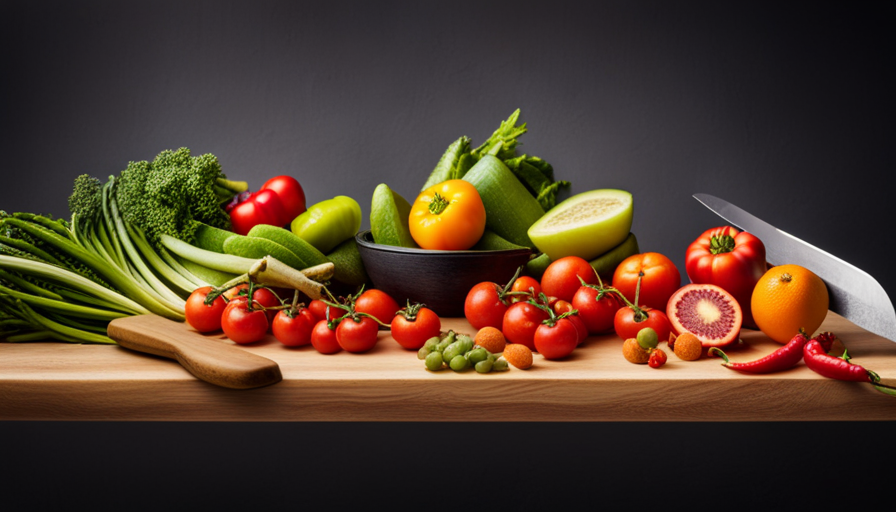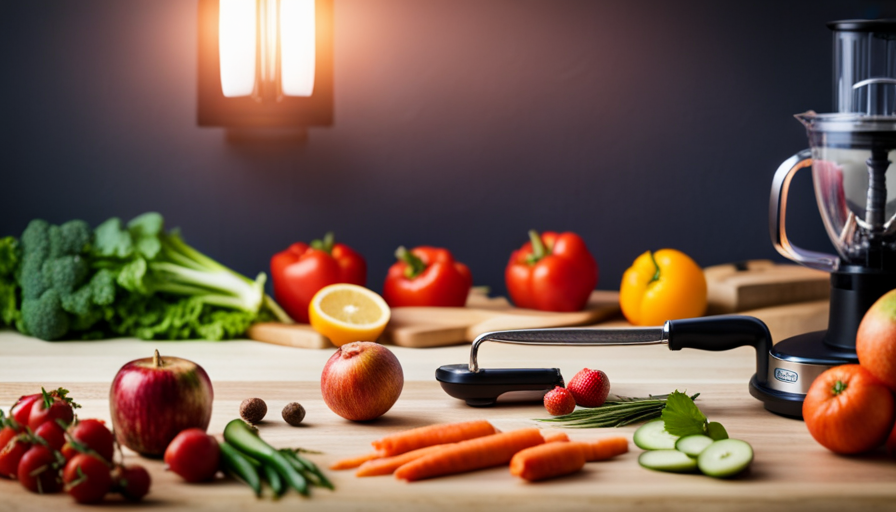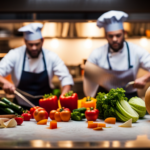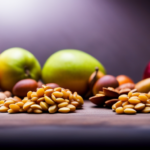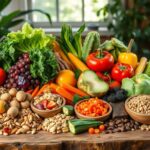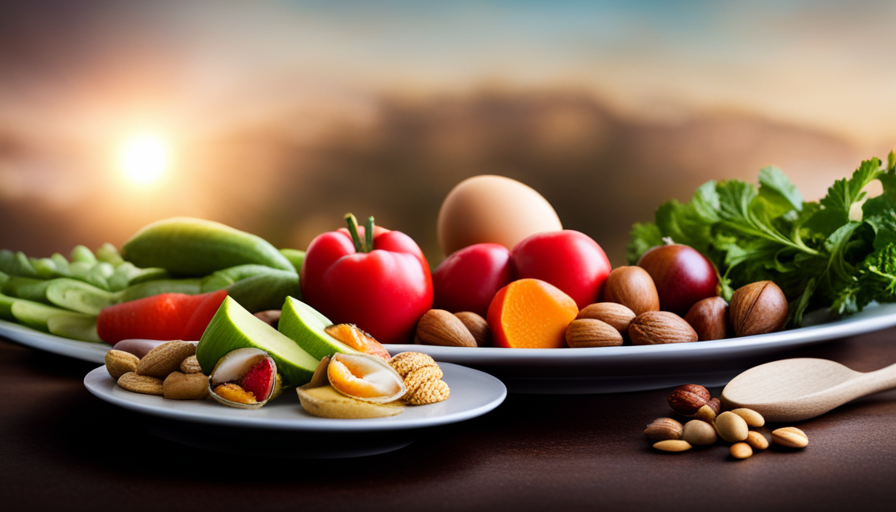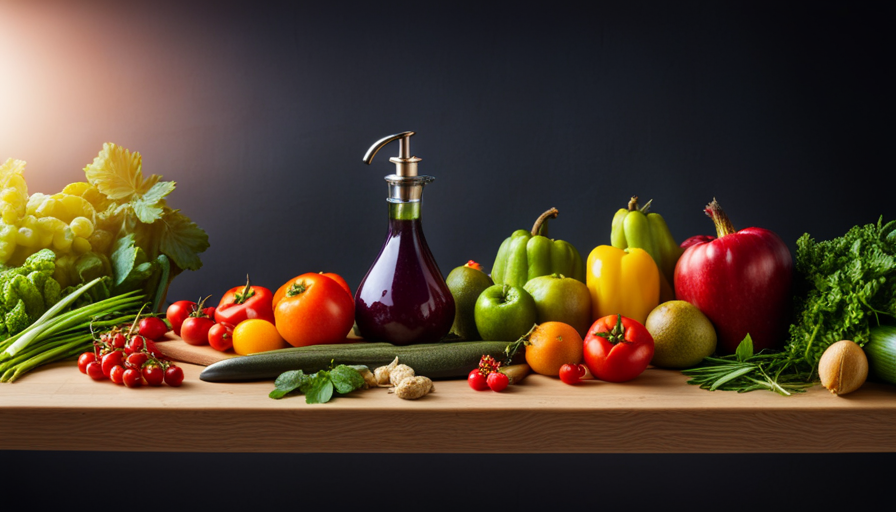Have you ever thought about the amazing power of unprocessed, raw food? Get ready to be impressed as we explore the realm of raw foods – the most natural form of nourishment from nature!
Raw foods, simply put, are uncooked, unprocessed, and unadulterated ingredients that are packed with vital nutrients and enzymes. They are the superheroes of the culinary world, bursting with vibrant colors, tantalizing flavors, and unparalleled health benefits.
From crunchy vegetables to luscious fruits, sprouted grains to creamy nut butters, raw foods offer a tantalizing array of options to tantalize your taste buds and revitalize your body. Whether you’re a seasoned health enthusiast or just curious about the raw food movement, this article will guide you through the fascinating realm of raw foods, revealing their benefits, types, and ways to incorporate them into your diet.
Get ready to embark on a journey that will transform the way you think about food and nourish your body from the inside out.
Key Takeaways
- Raw foods are uncooked, unprocessed, and unadulterated ingredients packed with vital nutrients and enzymes.
- They are rich in vitamins, minerals, and antioxidants that are easily absorbed by the body.
- Consuming raw foods can lead to improved skin health, reducing inflammation and preventing premature aging.
- Raw foods include fruits, vegetables, nuts, seeds, and sprouted grains.
Definition and Explanation of Raw Foods
You can think of raw foods as uncooked, whole foods that retain all of their natural nutrients and enzymes, like vibrant fruits, crisp vegetables, and juicy sprouts. Raw foods are not processed or heated to temperatures above 118 degrees Fahrenheit (48 degrees Celsius), as this is believed to preserve the nutritional value and enzymes present in the food.
The definition of raw foods varies, but it generally includes fruits, vegetables, nuts, seeds, and sprouted grains. These foods are consumed in their natural state or prepared using methods like juicing, blending, or dehydrating at low temperatures. The raw food diet is based on the principle that cooking food can destroy essential nutrients and enzymes, which are important for digestion and overall health.
There are several benefits associated with consuming raw foods. Firstly, raw foods are rich in vitamins, minerals, and other essential nutrients that are easily absorbed by the body. Secondly, raw foods are usually low in calories and high in fiber, making them beneficial for weight management. Additionally, a raw food diet is often associated with increased energy levels, improved digestion, and a reduced risk of chronic diseases like heart disease and diabetes.
Transitioning into the subsequent section about the benefits of consuming raw foods, it’s important to explore how incorporating more raw foods into your diet can positively impact your health and well-being.
Benefits of Consuming Raw Foods
One interesting statistic is that consuming raw foods can lead to a higher intake of essential nutrients and enzymes, which can contribute to improved digestion and overall health. Here are some benefits of including raw foods in your diet:
-
Increased nutrient intake: Raw foods are rich in vitamins, minerals, and antioxidants that are essential for our body’s optimal functioning. By consuming them in their raw form, we can maximize the nutrient content and absorb them more effectively.
-
Enhanced digestion: Raw foods contain natural enzymes that aid in the breakdown and digestion of food. These enzymes are often destroyed during cooking processes. By consuming raw foods, we can support our digestive system and improve nutrient absorption.
-
Weight management: Raw foods are generally low in calories and high in fiber, making them a great choice for weight management. They provide a feeling of fullness and can help prevent overeating, leading to weight loss or maintenance.
-
Improved skin health: Raw foods are packed with antioxidants and nutrients that promote healthy skin. They can help reduce inflammation, prevent premature aging, and enhance the natural glow of your skin.
While there are numerous benefits of consuming raw foods, it’s important to note that there are also potential risks associated with certain raw foods, such as the risk of foodborne illnesses. Therefore, it’s essential to choose fresh and high-quality raw foods and properly wash and handle them to minimize any potential risks.
Moving on to the next section about types of raw foods…
Types of Raw Foods
Now let’s explore the various delectable options that fall under the umbrella of uncooked cuisine. Raw foods encompass a wide range of options, from fruits to vegetables. When it comes to fruits, there are endless choices to satisfy your taste buds. Juicy and sweet strawberries, refreshing watermelon, tangy pineapples, and creamy avocados are just a few examples. These fruits not only provide essential nutrients like vitamins and minerals but also offer a natural sweetness that can curb cravings for processed sugars.
On the other hand, raw vegetables offer their own set of benefits. Crunchy carrots, crisp bell peppers, and leafy greens like spinach and kale are packed with fiber, antioxidants, and phytochemicals. These nutrients play a crucial role in maintaining overall health and reducing the risk of chronic diseases.
To provide a visual representation of the variety of raw foods, here is a table showcasing some popular options:
| Fruits | Vegetables |
|---|---|
| Strawberries | Carrots |
| Watermelon | Bell peppers |
| Pineapples | Spinach |
| Avocados | Kale |
Incorporating raw foods into your diet can be a simple and delicious way to boost your health. By adding fruits and vegetables to salads, smoothies, or simply enjoying them as snacks, you can reap the benefits of their nutrients and flavors. Transitioning into the next section, let’s now explore how to incorporate these raw foods into your daily meals seamlessly.
How to Incorporate Raw Foods into Your Diet
Let’s discover some simple and tasty ways to add the natural goodness of uncooked ingredients to your daily meals! Incorporating raw foods into your diet can provide numerous health benefits. Here are five easy ways to incorporate raw foods:
- Start your day with a raw fruit smoothie packed with antioxidants and vitamins.
- Snack on raw vegetables like carrots, celery, and bell peppers with a delicious homemade hummus.
- Add a handful of raw nuts or seeds to your salads or yogurt for an extra dose of healthy fats and protein.
- Create refreshing raw salads by combining leafy greens, colorful vegetables, and a homemade dressing.
- Enjoy raw desserts like fruit sorbets or raw chocolate mousse made from avocados and cacao powder.
Incorporating raw foods into your diet can improve digestion, boost energy levels, and promote weight loss. Raw foods are rich in enzymes, which aid in digestion and absorption of nutrients. They’re also high in fiber, which helps maintain a healthy digestive system.
Additionally, raw foods are packed with vitamins, minerals, and antioxidants that support overall health.
To ensure you get the most out of your raw foods, it’s important to buy and store them properly. Let’s explore some tips for buying and storing raw foods without compromising their freshness and quality.
Tips for Buying and Storing Raw Foods
When it comes to incorporating raw foods into my diet, there are a few key points I always keep in mind. First and foremost, I prioritize choosing organic and local options whenever possible. Not only do organic foods tend to be free from harmful pesticides and chemicals, but supporting local farmers also helps to reduce my carbon footprint.
Additionally, proper storage techniques are crucial to maintain the freshness and quality of raw foods. I make sure to store them in airtight containers in the refrigerator to prevent spoilage and extend their shelf life.
Lastly, I always consider food safety when handling raw foods. I wash all fruits and vegetables thoroughly before consuming, and I pay attention to expiration dates and signs of spoilage to avoid any potential health risks.
Choosing Organic and Local Options
Opting for organic and locally sourced ingredients ensures that you’re getting the freshest and most vibrant flavors straight from the earth. Not only do organic foods taste better, but they also have a lower environmental impact. Organic farming practices promote biodiversity, reduce pollution, and conserve water and soil resources. By choosing organic options, you support sustainable agriculture and protect both your health and the planet.
To help you make informed choices, here is a table summarizing the benefits of organic and local options:
| Benefits of Organic and Local Options |
|---|
| Fresher and more flavorful |
| Reduced exposure to pesticides |
| Supports local farmers and economy |
| Promotes sustainable agriculture |
| Reduces carbon footprint |
Choosing organic and local options is just the first step towards a healthier and more sustainable lifestyle. Now let’s explore proper storage techniques to maximize the freshness and nutritional value of your raw foods.
Proper Storage Techniques
To ensure the utmost freshness and nutritional value of your ingredients, it’s essential that you employ proper storage techniques.
Proper storage techniques not only help extend the shelf life of raw food but also preserve their health benefits. One important technique is to store raw food in airtight containers in the refrigerator. This helps prevent the growth of bacteria and maintains the quality of the ingredients.
Additionally, some raw foods, like leafy greens, can be stored in a damp paper towel to maintain their crispness.
It’s also important to keep raw food separate from cooked food to prevent cross-contamination.
By following these proper storage techniques, you can maximize the health benefits of raw food and ensure its safety.
Moving on to food safety considerations, it’s important to take certain precautions when handling raw food.
Food Safety Considerations
Now that we’ve discussed proper storage techniques for raw food, it’s important to consider the food safety regulations and potential health risks associated with consuming raw food.
Raw food, especially meats, poultry, seafood, and eggs, can be contaminated with harmful bacteria such as salmonella or E. coli. These bacteria can cause foodborne illnesses, leading to symptoms like nausea, vomiting, diarrhea, and even hospitalization in severe cases.
To ensure food safety, it’s crucial to follow proper handling and cooking practices when dealing with raw food. This includes washing hands thoroughly, avoiding cross-contamination, and cooking food to the recommended internal temperature.
Additionally, it’s essential to be aware of any recalls or warnings regarding raw food products. By taking these precautions, we can minimize the potential risks associated with a raw food diet and enjoy its benefits.
Potential Risks and Precautions of Raw Food Diet
Although touted as a natural and healthier alternative, indulging in a raw food diet can expose individuals to potential risks and necessitate taking precautions. While raw food enthusiasts claim potential health benefits and weight loss effects, it is crucial to be aware of the potential risks associated with this diet.
One of the main concerns with a raw food diet is the risk of foodborne illnesses. Raw foods, especially meats, eggs, and dairy products, can harbor harmful bacteria such as Salmonella and E. coli. To mitigate this risk, it is essential to ensure proper food handling, including washing fruits and vegetables thoroughly and storing perishable items at the correct temperature.
Another consideration is nutrient deficiencies. Raw food diets often restrict certain food groups, such as grains and legumes, which can lead to inadequate intake of essential nutrients like iron, calcium, and vitamin B12. It is vital to plan a well-balanced raw food diet to ensure all nutritional needs are met.
To illustrate the potential risks and precautions of a raw food diet, consider the following table:
| Potential Risks | Precautions |
|---|---|
| Foodborne illnesses | Proper food handling |
| Nutrient deficiencies | Well-balanced diet |
| Contamination | Clean preparation area |
While a raw food diet may offer potential health benefits and weight loss effects, it is important to be aware of the potential risks and take necessary precautions. By understanding these risks and following proper food safety guidelines, individuals can safely enjoy the benefits of a raw food diet. Now, let’s explore some delicious raw food recipes and meal ideas.
Raw Food Recipes and Meal Ideas
Get ready to tantalize your taste buds with these mouthwatering recipes and meal ideas that embrace the natural goodness of uncooked ingredients. Raw food recipes aren’t just nutritious but also delicious, offering a vibrant and refreshing twist to your dining experience. Whether you’re a seasoned raw foodie or just looking to incorporate more raw meals into your diet, these recipes will surely satisfy your cravings.
One great way to explore the world of raw food is by trying out raw food restaurants. These establishments specialize in creating delectable dishes that are made entirely from raw and unprocessed ingredients. From zucchini noodles with a creamy avocado sauce to sushi rolls filled with fresh vegetables and sprouts, there are endless options to choose from. These restaurants often offer a variety of gourmet dishes that showcase the creativity and versatility of raw cuisine.
If you have a sweet tooth, raw food desserts are a must-try. These guilt-free treats are made with wholesome ingredients like nuts, dates, coconut oil, and cacao powder. From raw chocolate mousse to strawberry cheesecake, these desserts aren’t just delicious but also nourishing for your body.
Now that you have some tantalizing recipes and meal ideas to try, let’s dive into the inspiring success stories and testimonials of individuals who’ve embraced the raw food lifestyle.
Success Stories and Testimonials
Embracing the raw food lifestyle has led to incredible transformations and remarkable achievements for those who’ve shared their success stories and testimonials. People have reported experiencing a wide range of health benefits from adopting a raw food diet.
Here are some of the success stories and health benefits that individuals have experienced:
-
Weight loss: Many individuals have successfully shed excess pounds and maintained a healthy weight by following a raw food diet. The high fiber content and low calorie density of raw fruits and vegetables promote satiety and help in managing weight.
-
Increased energy levels: Raw foods are rich in essential nutrients and enzymes, which can boost energy levels and improve overall vitality. People have reported feeling more energized and alert after transitioning to a raw food lifestyle.
-
Improved digestion: Raw foods are easier to digest as they contain natural enzymes that aid in the breakdown of food. Many individuals have noticed a significant improvement in their digestion and have experienced relief from digestive issues such as bloating and constipation.
-
Enhanced skin health: The abundance of vitamins, minerals, and antioxidants in raw fruits and vegetables can promote healthy skin. Many individuals have reported clearer, brighter, and more radiant skin after adopting a raw food diet.
Transitioning to a raw food lifestyle can bring about these incredible success stories and health benefits. However, there are also common myths and misconceptions about raw foods that need to be addressed.
Common Myths and Misconceptions about Raw Foods
One common misconception is that a raw food lifestyle is restrictive and lacks variety, but in reality, there are endless creative and delicious options available. Many people believe that raw food only consists of plain salads and raw vegetables, but this is far from the truth. Raw food enthusiasts have come up with innovative recipes that mimic cooked dishes, such as raw lasagna made with zucchini noodles and cashew cheese, or raw chocolate mousse made with avocado and cacao powder.
To debunk another myth, raw food is not synonymous with a lack of nutrients. In fact, raw foods are often packed with vitamins, minerals, and enzymes that can be lost during the cooking process. Raw fruits and vegetables are rich in antioxidants, which help fight against free radicals and reduce the risk of chronic diseases. Additionally, raw foods are typically low in calories and high in fiber, making them an excellent choice for weight management.
Here is a table showcasing some common misconceptions about raw food and the actual truth behind them:
| Common Misconception | Truth |
|---|---|
| Raw food lacks flavor | Raw food can be incredibly flavorful when prepared with the right ingredients and seasonings. |
| Raw food is time-consuming to prepare | While some raw recipes may require soaking or marinating, many can be made quickly with minimal prep time. |
| Raw food is expensive | While some specialty ingredients can be pricey, a raw food diet can be affordable by focusing on seasonal and locally sourced produce. |
| Raw food is not filling | Raw food can be just as satisfying and filling as cooked food, especially when incorporating healthy fats and proteins. |
| Raw food is only for vegans | Raw food is enjoyed by both vegans and non-vegans alike, as it offers a variety of health benefits regardless of dietary preferences. |
There are many common misconceptions about raw foods, but the truth is that they offer a wide range of health benefits and delicious options. By incorporating raw foods into your diet, you can enjoy flavorful meals while reaping the nutritional advantages they provide.
Conclusion and Final Thoughts
Incorporating these nutrient-rich, flavorful options into your diet will leave you feeling satisfied and energized, while also supporting your overall health and well-being. Raw foods provide a plethora of benefits, and they can be easily incorporated into busy lifestyles. However, it’s important to acknowledge the challenges that come with maintaining a raw food diet.
One of the main challenges is time management. Raw foods often require more preparation and planning compared to processed or cooked foods. The need for washing, chopping, and blending can be time-consuming, especially for those with hectic schedules. However, with proper meal prepping and organization, this challenge can be overcome.
Another challenge is the lack of variety and convenience. Raw food diets mainly consist of fruits, vegetables, nuts, and seeds. This limited range of options can make it difficult to satisfy cravings or find convenient on-the-go snacks. However, with creativity and exploration, there are numerous ways to add variety to a raw food diet. Incorporating smoothies, salads, and raw desserts can help diversify the menu.
Despite these challenges, the benefits of incorporating raw foods into your diet are undeniable. They’re packed with essential nutrients, enzymes, and antioxidants that can improve digestion, boost immunity, and promote overall health. It’s important to find a balance that works for you and to listen to your body’s needs. By incorporating raw foods into your diet in a mindful and sustainable way, you can reap the rewards of this nutrient-dense approach to eating.
Frequently Asked Questions
Can I still consume cooked foods while following a raw food diet?
Sure, I understand the appeal of cooked foods. Who doesn’t love a warm, comforting meal? But if you’re following a raw food diet, the idea is to mainly consume uncooked, plant-based foods. However, that doesn’t mean you can’t have any cooked food alternatives. Some people on a raw food diet choose to include small amounts of cooked foods like steamed vegetables or grains. Ultimately, the benefits of raw food include increased nutrient intake and improved digestion.
Are there any specific nutrients that are more easily absorbed from raw foods?
There are several easily absorbable nutrients that can be found in raw foods, which contribute to the benefits of a raw food diet. For example, raw fruits and vegetables are rich in vitamins, minerals, and enzymes that may be lost or destroyed during cooking. These nutrients are readily available for absorption by the body, promoting optimal health and digestion.
However, it’s important to note that cooking can also enhance the availability of certain nutrients, so a balanced approach is key.
Can I still get enough protein on a raw food diet?
Getting enough protein on a raw food diet is definitely possible. While it may seem challenging at first, there are plenty of protein sources available in a raw food diet.
Foods like nuts, seeds, legumes, and leafy greens are excellent sources of protein. Additionally, incorporating sprouted grains and fermented foods can also boost protein intake.
The benefits of a raw food diet include improved digestion, increased energy levels, and enhanced nutrient absorption.
Are there any potential side effects of transitioning to a raw food diet?
There are potential health risks associated with transitioning to a raw food diet. Some people may experience digestive issues, such as bloating or gas, as their bodies adjust to the change in diet. It’s important to gradually introduce raw foods and listen to your body’s needs.
To minimize potential side effects, make sure to consume a variety of nutrient-dense foods and consider consulting with a healthcare professional or registered dietitian for personalized guidance and support.
Are there any specific guidelines for safely preparing and handling raw foods at home?
Safety guidelines for handling raw foods at home are crucial to prevent foodborne illnesses. To ensure safety, follow these simple steps:
- Separate raw foods from cooked foods to avoid cross-contamination.
- Wash hands thoroughly before and after handling raw foods.
- Use separate cutting boards and utensils for raw and cooked foods.
- Cook raw meats, poultry, and seafood to their recommended internal temperatures.
- Refrigerate perishable raw foods promptly.
By following these guidelines, you can reduce the risk of foodborne illnesses and enjoy the benefits of a raw food diet safely.
What are the Benefits of Eating Raw Foods?
Raw food classification is essential for understanding the benefits of eating raw foods. By consuming raw fruits, vegetables, nuts, and seeds, you can retain more nutrients and enzymes that are often lost during cooking. This can lead to improved digestion, increased energy levels, and a stronger immune system.
Conclusion
In conclusion, incorporating raw foods into your diet can be a transformative journey towards optimal health and vitality. Just like a seed that blossoms into a beautiful flower, raw foods have the power to nourish and rejuvenate our bodies from within.
By embracing the natural goodness of uncooked, unprocessed foods, we can unlock a world of vibrant flavors and nutrients. So, let’s take a bite out of life and savor the raw food revolution, allowing our bodies to bloom and flourish like never before.

